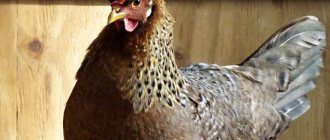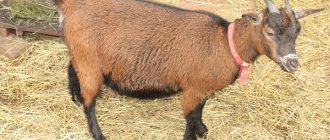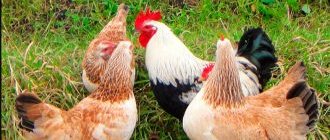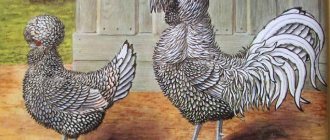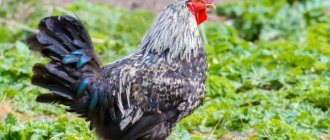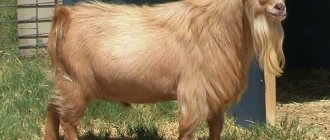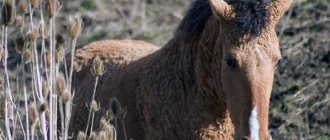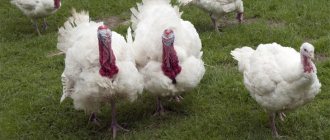Breeding Features
When forming a parent flock, it is necessary to select roosters that are not too large.
Laying hens should begin to be selected in January. Their hatching instinct is not particularly reliable - it is best to use an incubator. The optimal time for incubating eggs is early January.
The color of the plumage of shamo chicks is very different: it can be either white or black. Sometimes the color can consist of several shades.
The chicks must be kept in a large enclosure, as they are aggressive from birth and mutilate each other. The first fights between roosters begin as early as 2 weeks. At this time, they must be seated, otherwise they may injure each other.
Each one needs a separate cage. In some cases, there may be several cockerels, but you will have to watch them constantly.
It is advisable to vaccinate - shamo chicks are vulnerable to many diseases. What vaccinations need to be done, read the article “About vaccination of chickens: we vaccinate at home.”
Hatching and feeding chicks
For breeding, fighting breeding chickens are formed in early December. Dry combined feed for laying hens and a mixture of grains, 20 g per individual, is an ideal diet during this period. To help ensure a healthy brood, you need to add lighting at the time of hatching. After birth, the chicks are kept on warm bedding (optimally 33 0C). Newborns are fed a combination chicken feed. Vitamins are given along with water once a week. After two weeks, vegetables are added to the diet. After banding, the chicks are transferred to grain fodder for the young. The young animals are walked for several hours a day in a large green paddock. Due to the slow growth of feathers, birds need to be kept clean.
There are several styles in cockfighting. Each of them has its own characteristics:
- straight or mounted - when the rooster sees the enemy, he immediately goes on the attack, hitting directly in the head or chest;
- circled - at first the fight goes calmly, the rooster attacks without undue aggression. After which the chicken begins to run around the enemy. After a while, she suddenly strikes and runs away. Then it circles around the opponent again and attacks again. The bird continues these “circles” until the enemy is completely exhausted. Everyone is accustomed to consider this fighting style to be a good tactic, but it does not work against sent combat;
- sent - the rooster attacks aggressively from the brace. Hit from behind directly to the head;
- thievish - the bird leads a boring fight, constantly trying to avoid hitting its head. Then he tries to play with the enemy, hiding under his wing or falling at his feet. When the opponent has exhausted his strength, the rooster delivers several strong blows to the head.
The bird is fully formed by two years. Suitable for combat from 8 months.
They are released for battle when the chicken masters at least one style. The duration of the fight for which the birds are taken out depends on their skill in fights.
Chick care
Unfortunately, the percentage of surviving chicks is not very high - rarely exceeds more than 70%. The weak die in the first days and even hours of life. The fact is that they are very sensitive to the slightest temperature changes, not to mention drafts.
Infections pose an additional danger. Therefore, it is necessary to maintain cleanliness at the highest level.
In the first days of life, the best food for chickens will be boiled millet and hard-boiled eggs. Gradually, you can introduce finely chopped greens - dandelions, young nettles.
Features of breeds of fighting cocks and chickens
Currently, there are many fighting breeds. Oddly enough, not all of them are aggressive. There are purely decorative species that can get along even with ordinary chickens. If a breeder decides to make money on bets, he must choose birds with an “explosive” temperament. The most popular pugnacious breeds include Shamo, Sumatra, Taigo, Dakan and Azil.
Shamo
Translated from Japanese, "shamo" means "fighter". Shamo fighting cocks are divided into three categories: large, medium, and dwarf. The only difference between them is size.
Shamo
Chickens of the Shamo breed are distinguished by their long, wide skull and “muscular” cheeks. Their elongated neck has a smooth curve. The chest is powerful, well developed, protruding forward with a “bare bone”. The color palette is varied: white, gray, black and spectacular color combinations. The most common colors are gray and black. The neck, legs and tail may be red, orange and brown. The legs and beak are bright yellow.
- Rooster Shamo is an excellent fighter. Long, strong fingers give the bird stability, and sharp spurs inflict wounds on the enemy. The small wings and tail are very difficult to pull out, giving the rooster an advantage in battle.
- Chickens of the Shamo breed are smaller in size, but have all the fighting qualities. Dense plumage forms “armor” and protects from wounds. Shamo easily detect the enemy's pressure points and deliver piercing blows.
The average cost of a bird is 3,300 rubles*.
Sumatra
The Sumatra chicken is an ancient indigenous breed that evolved without human intervention. The Indonesian green chicken has been cited as a possible ancestor.
The Sumatran fighting chicken is usually black in color. Feathers are cast blue or green. Breeding forms are distinguished by blue, white and copper feathers. The head is painted carmine.
Sumatra
Roosters have a small red crest and double sharp spurs. The birds' "faces" are purple with red earrings. The beak is slightly curved downwards, strong and sharp. The legs are long, strong, and painted black. The soles are yellow. Females are smaller than males and lighter by 1.5 kg.
Sumatra are aggressive and pugnacious chickens. Despite its non-decorative appearance, it can be very dangerous, so it is suitable only for experienced poultry keepers. Sumatra often attacks poultry and requires separate housing.
These fighting chickens can rise to a considerable height. Therefore, their territory must be fenced with a high fence. Roosters often bully each other and can start a serious fight.
On average, Sumatra costs from 2.5 to 11 thousand rubles*. Eggs are sold for 180 rubles*.
Korean
The Taigo breed comes from Korea, so the birds are traditionally called Koreans. This is a rare and expensive species: one egg costs from 10 to 12 thousand rubles*. To calculate how much an adult is worth, you need to take into account the pedigree and “sports” qualities.
These fighting chickens will not be cheap: a Korean in Moscow costs up to 60,000 rubles*.
Taigos are colored black with a green tint. They have a thick and spreading tail. Paws are white or yellow.
Korean
Koreans are real gladiators. They jump on top of the enemy and deliver a precise blow to the back of the head. They can attack head-on.
Dakan
The second name is Kulangi. Currently, only enthusiasts breed them. Dakans are native to Central Asia. They were bred through folk selection.
Dakan
They are distinguished by strong bones, massive physique and fleshy paws. Dakans have two color options: black and light salmon. Their feathers fit tightly to the body and protect it from blows. The legs of the kulangi are decorated with sharp spurs. The flattened shape of the skull avoids injury and helps withstand strong impacts. The beak is short, sharp, slightly curved.
The breed is known for its wild and cocky disposition. Dakan is a formidable opponent in the ring. Asian fighting chickens are promising and highly trainable.
Azil
Azil is an Indian fighting cock. One of the most popular breeds. In Europe he is known by the nickname "raja".
Azil is a medium-sized bird with strong bones. It is distinguished by short but strong legs. Color options: gray, red, brown. The beak remains large and sharp.
Azil
Azil is well trained and successful in the ring. His stamina allows him to participate in several fights per day, most of which he will win. Peak physical fitness occurs at the age of two.
Important! Azil needs increased protein nutrition. The average cost of a bird is 4,000 rubles*. The average cost of a bird is 4,000 rubles*
The average cost of a bird is 4,000 rubles*.
What directions are roosters divided into?
Over the years of breeding, chicken breeds (and their corresponding roosters) have been divided into many groups:
- Meat. They are distinguished by their rapid growth and bright taste of meat. These include Brahma, Cochin, etc. Broilers also belong to this category - the result of interbreeding. Broiler chickens grow one and a half to two times faster than any meat or egg breed, but their meat is considered to be of lower quality, and during breeding the properties of broilers do not appear. When you try to lay broiler eggs in an incubator or under a brood hen, the result is chickens whose properties, at best, demonstrate the classic “Mendelian split.”
- Egg. In this case, selection among hens is carried out based on egg production, and roosters are preserved only so that the breed or cross can continue further through brood hens. These are the chickens that are mainly bred in poultry farms.
- Meat and egg are mixed varieties that demonstrate both good egg production and rapid growth and gain of muscle mass for consumption.
- Decorative. These breeds do not produce good egg production or meat - but the roosters are very beautiful due to their comb, beard and earrings, as well as long and bright plumage.
- Fighting cocks. These breeds are not at all selected for the taste of meat or egg production - but, first of all, the most aggressive individuals are selected, winning in battles with their relatives.
- Vociferous. Here, selection is not at all connected with either commercial or decorative qualities - roosters are bred, and chickens of this breed are preserved only as a source and breeding reserve.
Fighting cocks from Central Asia with a cocky disposition. A breed for those who love active birds
Dakans
Yokohama
A Chinese-Japanese breed of fighting cocks, distinguished by a luxurious tail and proud posture
Shokoku
Ayam-pelungi
Training
The way a fighting bird is trained depends on its ability to fight, that is, to take part in competitive events.
Roosters are usually trained by the breeder himself.
It is important to properly psychologically configure fighting birds. Effective learning requires a special psychological climate and rigidity in education.
To train birds well, it will take a lot of time; the process must begin at nine months of chicken age.
Often the first cockfight is a fight with an opponent in the form of your own shadow. The fighter gains passion and experience. An important thing is to train the beak and claws. To create a fighting spirit, roosters are kept in separate cages or enclosures.
The main methods of combat training are expressed in:
- running on a wheel inside a pen or cage;
- footrests on the back to enhance reaction and alertness;
- in hanging foot weights of 300 or 400 grams.
Popular breeds
Kulangi
Kulang chicken breed
This species is very old.
The individual has a rather aggressive and cocky disposition. Representatives of the species do not tolerate cold well.
The individual is characterized by its large size. The average live weight of males reaches 4.5-5 kg, for females - 3.5-4 kg. The level of egg production of these laying hens is not very encouraging - about 100 eggs per year. Based on this, chickens are not particularly suitable for breeding in backyard poultry farms. Oviposition begins at the age of six months.
English
English fighting breed of chickens
Birds are distinguished by the variety of possible colors.
They are unprofitable in terms of their productivity. The weight of males is about 2-3 kg, for females - 1.75-2.5 kg. Eggs weigh 55-60 g. The shell color is yellow or white.
Indian fighters
Indian fighting chicken breed
Representatives of this species have excellent fighting characteristics. India is not the birthplace of chickens. When and how this individual appeared still remains a mystery. Birds are quite picky in terms of maintenance.
These fighting birds have an evil disposition. Often conflicting.
Individuals are typically quite large in size. The weight of cockerels reaches 4.5-5 kg, in hens - 3-3.5 kg. Most farmers raise them as their main source of meat.
Shamo chicken breed
These birds come from Japan. Birds are characterized by good endurance and physical strength. There are 3 types of breed: large, medium, and dwarf.
In individuals of a large species, the weight of males is about 4-5 kg, in females - 3-4 kg.
In medium-sized cockerels, the weight is 3-4 kg, in hens – 2.5-3 kg.
In dwarf representatives, the weight of males barely reaches 0.8-1 kg, in laying hens - 0.6-0.8 kg.
All feathered shamo differ from each other only in size.
Malay
Malayan fighting chicken
The individual belongs to one of the oldest fighting breeds.
The weight of females is 2.5-3 kg, and that of males is 3.5-4 kg. The level of egg laying is within 100-120 eggs throughout the year. The color of the shell is cream. The eggs weigh about 57 grams.
Moscow
The variety is divided into two types - fighting and meat. Chickens are characterized by a rather aggressive character, they are quite strong and also hardy. There are few breeds with such qualities.
Moscow chicken stands out for its good meat productivity data. Average weights for males are about 3.5-6 kg, for females - 2.7-3 kg. The level of egg laying is 100-120 eggs per year. The shade of the shells is usually brownish, they weigh about 53-55 grams.
Uzbek
This individual represents a rather old species.
The average weight of cockerels varies from 4 to 7 kg, for hens - 2.8-3.5 kg. The level of egg laying is about 100-120 eggs per year. The shade of the shell is brownish. Eggs weigh 57-62 g.
Spanish fighting chickens
Photo of fighting Spanish breed of chickens
These birds are relatively small in size. They have a rather aggressive character. Chicken farming is carried out mainly in South America. The average weight of a bird is 1.4-1.5 kg.
Old English dwarf
Old English breed of chickens in the photo
Representatives of birds were created quite a long time ago, in England. The bird has a bold and also proud disposition. These fighting birds are easy to train. The weight of males is 0.75-0.8 kg, females - 0.65-0.7 kg.
Suzdanesian fighting chickens
Sundanese fighting chickens are native to Indonesia. In 1970, they were brought to Europe, and they were bred directly in Holland. The bird is characterized by medium dimensions. The weight of a cockerel reaches 2.5-3 kg, and that of hens 2-2.5 kg.
Azil
This individual is a representative of the most ancient fighting variety. The birds' temperament is quite lively and also aggressive.
Madagascar chickens are fierce warriors and responsible parents
From the hot climate of Madagascar, we came to us with rather scary-looking but hardy bare-necked Madagascar chickens. They are distinguished by their remarkable health. Back in their homeland, these fighters are used to fighting under the scorching sun or pouring rain and feeling good after that. Even bad weather does not prevent chickens from growing quickly and gaining weight.
The appearance of the bird is capable of instilling fear even in a person and fully corresponds to its name:
- the feathers are smooth, fit tightly to the body, protecting the roosters from opponents’ blows, the coloring is dominated by red, black, white and brown;
- chest deep;
- the skeleton is strong, with well-developed muscles;
- the legs are powerful, yellow, widely spaced, with strong claws;
- the tail is small;
- the head is small and elongated, without lobes and earrings, with black evil eyes;
- the neck is red, long and bare;
- the beak is yellow, small but strong, in cockerels - with a fleshy growth;
- the comb is warty, small.
Bare-necked chickens are bred mainly for fighting, but they are also suitable for food. Young individuals have very tasty meat, with a dense structure. It is better not to slaughter old ones for this purpose, since the meat becomes tough with age.
When raising Madagascans in the Russian climate in winter, they need an insulated chicken coop. The bird does not tolerate cold well due to its origin.
Roosters
Males can have different weight categories. The weight of the smallest ones is 2 kg, large birds gain up to 5.5 kg. To quickly build muscle mass, special protein diets are often used. At the same time, the growth of roosters is impressive and sometimes reaches 80 cm.
The Madagascar rooster has an interesting and two-sided personality. This intelligent bird is highly trainable. In battle, she is cruel and merciless, she is not at all afraid of her opponent and will fight to the end no matter what. At the same time, the rooster awakens tender paternal feelings towards his offspring. Often dads even replace the hen, leading the chickens. The fighters are also friendly towards their master.
Due to increased aggressiveness towards members of the same sex, roosters are kept separately, otherwise they will kill each other. In addition, it is worth equipping some kind of treadmills for them. Without constant physical activity, roosters become overweight and lose their fighting qualities, being suitable only for meat.
Chicken
Naked hens, as usual, weigh less than roosters - a maximum of 3 kg. They do not grow above 50 cm in height. Chickens will not be pleased with their high egg production: the maximum number of eggs per year does not exceed 5 dozen, and in the first year no more than 3. An egg weighs no more than 65 g.
Specifics of cultivation
When raising roosters and chickens, a number of requirements must be observed. It is recommended to maintain an optimal temperature in the chicken coop. It should be +14-18 degrees.
It is recommended to monitor these indicators in winter and early spring. During this period, females lay eggs. If you do not provide them with suitable conditions, you should not count on the appearance of productive offspring.
It is worth ensuring that there are no drafts or excessive dampness in the poultry house. Japanese birds do not tolerate cold weather well. Despite their physical strength, they need to maintain temperature conditions.
In order for birds to develop normally, it is recommended to give vent to their aggression. If birds are constantly indoors, they will become very aggressive. This will lead to constant fights and injuries.
Roosters are trained in an open area. It is worth putting up a fence first to prevent other birds or animals from entering the aviary.
It is strictly forbidden to house birds of other breeds with Shamo roosters. Even calm chickens often suffer from attacks from these birds.
In addition, when breeding Shamo roosters, it is worth considering the following features:
It is recommended to systematically clean the enclosure. Be sure to clean floors and perches
Washing drinking bowls and feeders is of no small importance. The poultry house is periodically treated with antiparasitic drugs. It is worth monitoring the appearance of birds. It is recommended to pay special attention to the condition of the feathers. Perches should be placed at a relatively low height
This will help avoid injury to birds. It is recommended to adhere to the light regime. This is especially true during oviposition. Daylight hours should be at least 16 hours. When severe aggression appears in birds, they should be examined for diseases. It is recommended to isolate roosters that are too violent.
Descriptions of chicken breeds for meat and egg production for breeding at homeRead
Diets for feeding roosters
The basis of the diet for roosters is the same products that are used to feed chickens, but there are some peculiarities. It is necessary to know and take them into account depending on what kind of roosters you are raising - breeders, fighting ones or individuals intended for slaughter.
Standard
The optimal diet for roosters includes:
- grain crops;
- vegetables: fresh and boiled;
- animal feed;
- greenery;
- calcium supplements: fish meal, bone meal, crushed shells or chalk.
Moreover, the daily diet of roosters can include minerals, fruits and other sources of vitamins.
Farmers often base their rooster rations on household table waste, such as side dishes and bread. Thus, they want to save a lot on feeding the roosters. But with this approach to feeding, it is difficult to maintain the required proportions and provide balanced food.
There is also an alternative option - feeding with ready-made mixed feed, which is selected depending on the age of the rooster.
In addition to a balanced diet, it is also important for poultry to maintain a drinking regime. The water requirement for one adult is 200 ml daily. The volume of water should be increased if the birds' diet includes mainly dry food, and they are rarely fed wet gruel or fresh vegetables, which are also a source of life-giving moisture
The volume of water should be increased if the birds' diet includes mainly dry food, and they are rarely fed wet gruel or fresh vegetables, which are also a source of life-giving moisture.
For breeding roosters
For the fertilization of hens, the quality of the rooster’s seminal fluid plays a very important role; it, in turn, strongly depends on the bird’s diet.
IMPORTANT! The diet must be balanced to prevent roosters from gaining excess weight. Obese roosters become lazy, sedentary and inactive in matters of mating. A balanced diet and optimal portion sizes have a beneficial effect on:
A balanced diet and optimal portion sizes have a beneficial effect on:
- sperm quality;
- mating efficiency.
It is necessary to enrich the diet of feathered males with ready-made balanced feed compositions from non-standard containers, which will stimulate an increase in sexual activity.
The feeder is arranged as follows: V-shaped feeders are attached to the wall approximately 40-50 cm from the floor. They are filled with a nutritious composition: cereals with sprouts in a volume of approximately 50 grams, a calcium-containing additive - cottage cheese or bone meal - 7 grams, raw carrots - 20 grams, as well as yeast - 5 grams and fish oil in the amount of 1 gram.
Moreover, you can purchase supplements for roosters that increase the quality of seminal fluid.
For individuals for slaughter
The diet for roosters destined for slaughter is also changing. In this case, the bird’s diet should be enriched with protein foods - boiled eggs, cottage cheese or other dairy products.
In order for roosters to quickly gain weight, it is necessary to provide constantly full feeders. They should be filled with grain or other dry food. Roosters that will be slaughtered will actively gain weight if fed with ready-made broiler mixtures.
For fighting cocks
For special breeds of fighting cocks, it is important to provide a special diet. The basis here is compound feed, selected depending on the age of the bird. Ready-made mixtures can have different forms: granules or crumbly appearance
Since such foods are developed by specialists, all the necessary substances are included in their composition. Such nutrition ensures healthy growth and strength of the bird.
Ready-made mixtures can have different forms: granules or crumbly appearance. Since such foods are developed by specialists, all the necessary substances are included in their composition. Such nutrition ensures healthy growth and strength of the bird.
Fighting breeds of roosters require increased levels of proteins and vitamins. For this reason, in addition to ready-made food, they are given:
- boiled eggs;
- dairy products;
- meat;
- greens, sprouted wheat and other cereals.
Origin and characteristics of fighting chickens
There is a theory that absolutely all varieties of chickens originated from the Bank breed, originally from Central Asia, and fighting chickens are no exception. They became militant not due to human efforts, but as a result of the natural need to protect themselves and their space.
Having put the ability to defend territorial rights on the conveyor belt, enterprising farmers in each region acquired their own fighting breed, so there are many subspecies of aggressive birds.
The Bankivka chicken is the ancestor of all chicken breeds existing in the world.
Some scientists suggest that chickens became ferocious due to the meager diet on which ancient peasants kept them. The lack of useful elements and unbalanced nutrition made the meat of birds tough and dry, so it was practically not consumed as food. To find a use for domesticated creatures, they were used exclusively for combat purposes. A little later, the focus shifted to the magnificent colors of the plumage, and active breeding of ornamental breeds began. Then the turn came to meat, egg and meat-egg varieties.
Fighting breeds are the pride of folk selection
Appearance of fighting chickens
Based on the names, we can conclude that chickens of this variety are widespread: Malay, Indian black, English, Central Asian kulangi, Moscow - almost every corner of the planet has become involved in the breeding of fighting chickens
Since only males take part in fights, all the attention of breeders was focused on improving their athletic qualities, leaving the physical development of chickens to chance. The following body parts were targeted by breed improvement specialists:
- rib cage;
- paws;
- head.
They are the strategically important elements of the battle.
For the owners of the feathered army, it was very important to achieve a vertical position of the body
To win, the rooster had to have the following characteristics:
- Head. In order to reduce the likelihood of injury, it should be small in size, but with a thick frontal bone that can withstand strong blows from an opponent.
- Rib cage. It is desirable that the muscles be well developed, and the skeleton must be strong enough.
- Limbs. Since roosters jump long distances during the fight, the legs for jumping must be long and strong.
- Brow ridges. Well defined eyebrows give an intimidating look.
- Earrings. They are the weak link of the exterior and therefore must be removed. This procedure makes birds less vulnerable.
- Beak. The main weapon of the male must be as strong as steel.
- Plumage. Short and dense feathers are more difficult to tear out during a fight, therefore, individuals with a long protective cover cannot participate in battles.
- Character. Unscrupulous and cowardly specimens are subject to culling.
The task was difficult, but over centuries of practice, breeders succeeded in many ways.
Malayan fighting chickens
Modern fighting chickens look like this:
- small head;
- massive brow ridges;
- atrophied comb and earrings;
- strong beak;
- vertical orientation of the body;
- downed physique;
- elongated neck;
- muscular, protruding chest;
- strong limbs;
- short, close-fitting plumage to the body.
English fighting cock
Fighting chickens are absolutely different from their peaceful domestic relatives, both in character and in plumage color and exterior. Warlike birds weigh, depending on gender and breed, from 0.5 to 7 kg, and their life expectancy ranges from 10 months to 3 years.
From the history of cockfighting
In the countries of the Ancient East, fighting cocks appeared back in the 5th century. BC e. The fighting nature of ancient birds is explained simply: in order to survive, they fought for food. Around 700 BC. e. fighting chickens were brought to Babylon, and a little later to Greece. The Athenian commander built a special amphitheater for cockfights, where young townspeople were ordered to attend such performances in order to learn from the birds how to fight to the last.
Later, aggressive birds spread to Asia and Sicily. This caused opposition from the church, which did not prevent the spread of the exotic hobby.
Fighting chickens came to Russia in the 18th century. Count Alexey Orlov-Chesmensky brought them, ordering them in England. This fun spread among the nobles and lower classes; battles were organized by the Society of Cock Hunters.
At the beginning of the twentieth century. the bloody hobby was banned, but after 1917 Lenin abolished the pre-revolutionary decrees and the tradition resumed.
But at the beginning of the twentieth century. In Russia, as well as in most countries of Europe and America, bird battles were outlawed. But they are still carried out in France, Spain, in the countries of Asia and Latin America, and fighting poultry farming continues to develop there.
Egg production
The shamo hen can produce up to 60 eggs per year. For laying hens, it is necessary to create the most comfortable conditions to activate egg laying in late winter and early spring. This is the only way to collect eggs for incubation, and then place a hen on them or lay the eggs in an incubator.
Due to their unbridled temperament, chickens of this breed are very mobile and active. They are not very suitable as quons, since they do not have the patience to sit on the eggs until the logical conclusion of the process - the hatching of the chicks.
If you nevertheless decide to use these particular hens for hatching, you need to do this in complete isolation, where nothing distracts the hen from her maternal duties. A large shamo duck, due to its restlessness and hyperactivity, can crush eggs. Since eggs from chickens of this breed are already quite rare, it is advisable not to take risks and entrust the reproduction of chickens to an incubator.
When choosing an incubator for your home, pay attention to devices such as “Laying Hen”, “Ideal Hen”, “Cinderella”, “Blitz”.
How to train fighting birds
Main parameters
Fighting cock fights are a profitable form of entertainment. But at the same time it is a cruel sight.
Until the beginning of the 19th century, the battle continued until the death of one of the rivals. Later, a more gentle rule was introduced - the ability to stop the fight in case of severe bodily injury.
The first stage in preparing the event is the correct choice of the breed of fighting rooster. You can prepare a bird for battle only when it reaches nine months of age.
Before training begins, the rooster's wattles and comb are removed to stimulate aggression and to prevent injury during exercise.
The main direction in training is to develop jumping ability, strength, endurance, and precision in striking the enemy in a fighting cock.
1 training method
Goal: development of abilities focused on air combat - jumping and striking at the same time.
The roosters are forced to run in a wheel until their strength runs out. At the same time, the bird is constantly being tripped from behind, which develops its ability to escape a blow while jumping.
2 training method
Goal: the ability to fight on a hard surface. By lightly pressing on the back, the rooster is forced to walk on bent legs to train their endurance.
To develop muscle mass and endurance, a load weighing up to 400 g is tied to the rooster and forced to run in a circle or squat.
To force him to sit down, the owner presses the rooster by the withers with his hand, and he involuntarily sits down. This exercise is repeated until the bird gets tired.
Before training, the fighting cock's muscles are warmed up by rubbing with a sponge dipped in warm water. At first, a mirror is placed in front of the bird to develop aggression, perseverance and the ability to attack.
The main rule: training of fighting cocks must be regular and carried out by one owner. During classes, contact between the trainer and the rooster must be constantly maintained.
Maintenance and care
Kulangi are an unpretentious breed of chickens that get along in almost any conditions. However, they are sensitive to cold climates: in warm regions these birds feel much better. Poultry farmers note a high survival rate of offspring; almost all chickens from a brood grow up to be healthy and strong birds.
The chicken coop room should be warm and dry, and it should be ventilated regularly. For bedding, it is best to use sawdust or peat. The walking area can be the same as for other poultry.
To keep dakans in comfortable conditions, you need to allow the birds to move freely. However, they should be protected from contact with other inhabitants of the poultry yard. Due to the cocky nature of this breed, kulangi are constantly in conflict, and for other breeds of chickens in your yard, fights can end in tears.
Nutrition
To properly form the muscles of the kulangs, they need to be fed correctly. Their diet has some differences from the usual menu of laying hens or broilers. On the one hand, they need to gain muscle mass and have a strong skeleton, on the other hand, uncontrolled nutrition can cause obesity, which is a disadvantage for a fighting rooster.
For up to one and a half months, Kulang chickens are fed boiled eggs, alternating them with cottage cheese. Finely chopped onions and nettles are given as a source of vitamins. For mature birds, the menu should look like this:
- 25% - boiled potatoes;
- 25% - compound feed;
- 50% - plant foods (clover, dandelion, alfalfa, burdock, nettle).
Appearance and characteristics
The descriptions of most species are similar. The body is strong, the legs and neck are long, the head is small. The feathers are located close to the skin. The chest protrudes forward.
The comb and wattles are removed or atrophied. The beak is strong, the claws are strong. The character is aggressive, fearless. Weight from 0.5 to 7 kg.
Azil fighting chickens
Azil fighting chickensAzil is an Indian breed that came to Europe in 1860, suitable only for sport.
If they are crossed with other species, their fighting qualities are lost. Chickens weigh up to 2 kg, roosters 2 or more kg. Aggressive regardless of gender. In the ring they prefer a thieving style.
There are two subspecies of azil:
- Reza – weigh approximately 3 kg;
- Madras and South Indian - weight up to 6 kg.
The body is oval, the head is small, and there are no earrings. The legs are strong and have spurs. The color is often bright red. These birds are easy to train and love their owner.
Belgian fighting chickens
Homeland - Belgium (XVII century), weigh more than 4 kg. The physique is large, the muscles are dense. The character is not very vicious, the roosters are hardy. They are picky eaters and love food with protein.
Vietnamese fighting chickens
Vietnamese fighting Another name is Ga Dong Tao. This is a rare breed, bred in the villages of Vietnam, and is not found anywhere else.
Currently, this species is used not as a fighting breed, but as a meat breed. Legs are popular and are considered a delicacy.
Malayan fighting cock
The birthplace of the breed is Central and Asia Minor. The Asian's head is small and flattened on the sides. The beak is curved. The back is wide, the legs are high.
Malayan chickens weigh up to 3 kg, roosters from 3.5 or more.
Moscow fighting chickens
There are two types of Moscow chickens: meat and fighting. They weigh about 3 kg, roosters from 3.5 to 6 kg. The birds are hardy and vicious. The body is wide, the head is small with a small crest.
Be sure to read:
How to cure coccidiosis in broilers: symptoms, treatment and prevention
The beak is strong and curved. The color is often red.
Uzbek fighting chickens
The Uzbek breed is old. It was bred by selecting aggressive roosters. The body, neck and legs are long, the head is medium, and the tail is short. The color is different. Chickens weigh 2.8-3.5 kg, roosters - 4-7 kg.
Lari
Laris are clever opponents. Their legs are spaced apart. Weight about 2 kg, average height. Used exclusively for sporting purposes.
The neck is thick and large. This breed needs constant training so as not to forget fighting techniques.
Lutticher chickens
Lutticher The birthplace of the breed is Belgium (Lutticher). The birds are large, with well-developed muscles, average weight 4-5 kg. The claws are strong and sharp. The character is embittered.
Tuzo
The birthplace of the breed is Japan. The body is graceful and small. The muscles are toned, the shoulders are narrow. The head is wide and round. The weight is small (about 1.2 kg), but the birds are dexterous, aggressive and fearless.
Sumatran
The head is small with a red crest. The beak is strong, short, curved. Roosters have double or triple spurs with which they strike.
The tail is bushy, they are bred as decorative. They are aggressive and attack meat and egg breeds.
Yamato
Yamato The breed was bred by Japanese breeders to entertain emperors and lovers of cockfighting. Birds fight with any opponent, as they are hardy and aggressive.
Yamato is small in size, weak plumage, fleshy muzzle. The color is wheat or wild. Roosters have a wide, egg-shaped body. Legs are medium muscular.
Most common diseases
Many breeds have certain genetic deficiencies. And fighting chickens, photos of which are attached to the article, are no exception. Their main drawback is poor health. Even if you create excellent living conditions for them and provide them with high-quality food, a certain percentage of juveniles and even adults will die.
Most often, problems are caused by parasites. For example, ticks and fleas can carry bacterial and viral infections, and at the same time reduce overall immunity. To prevent this from happening, you need to periodically inspect the skin of the chickens.
Down eaters cause a lot of problems, destroying the already thin cover of down. Unfortunately, in this case it is usually not possible to cure chickens. It’s easier to put them under the knife - such a misfortune will not affect the taste of the meat in any way.
Another possible disease is asthma. But it usually occurs only under incorrect conditions. For example, if chickens live their whole lives in cramped, poorly ventilated and dusty rooms. If you provide good ventilation and clean air, you can be sure that the chickens will not encounter such an unpleasant disease.
Types and rules of cockfighting
There are 3 types of cockfighting:
- Match. Pairs of opponents are determined. The rooster with the most victories is declared the winner.
- Royal battle. All participants enter the ring, the survivor is declared the winner.
- Welsh fight. During the first battle, 8 pairs fight simultaneously. In the second round, 4 winners fight, then the two remaining males fight.
The winner was the rooster that survived the fight.
Cock-fights
All participants were grouped by age groups:
- young (up to one year);
- pereyarki (males older than a year who have moulted 2 times);
- tretyaks (three-year-olds);
- old (over 3 years old).
Young birds were released for fighting in October, adults - in November.
Previously, a victory was counted after the death of one bird. Today the rules have changed. A participant can be picked up at any time during the fight, including if he is seriously injured.
Features of the fighting style
There are 4 styles:
- direct - the bird flies up to the opponent and hits him in the head;
- circling – one participant circles around the opponent to exhaust him, then hits him;
- sent - blows are applied to the back of the head;
- thievish - birds take cover, run under the wing or at the feet of an opponent.
Cockfighting has been a favorite folk spectacle since ancient times. Roosters for fighting began to be bred several thousand years ago.
Both in those days and now, cockfighting captivates and captivates people in many countries. Such competitions are often held in the Philippines, Vietnam, Thailand, as well as in Uzbekistan, Kyrgyzstan and Dagestan.
Rooster competitions attract many fans of this sport, bets are placed on the birds, and the fighting roosters themselves are very expensive, the price can reach several thousand dollars.
One of the most common breeds of fighting cocks is Azil.
The birthplace of this breed is India. In ancient times, the word Azil was used to refer to all fighting chickens. This ancient breed was brought to Germany in the 19th century. In Europe, chickens of this breed are called “Rajah”.
DAKAN – A BIRD WITH CHARACTER
Cockfighting is still popular in Uzbekistan, Tajikistan, Kyrgyzstan, Turkmenistan and the southern part of Kazakhstan. This tradition goes back centuries. The bird was mainly kept by family clans, passed down from generation to generation.
How the fighters were trained, what they were fed with - everything was kept secret, and even more so they did not sell good poultry to anyone.
Fighting birds came to Central Asia along the Silk Road from the countries of India, China, and Persia and received the name Urushkok Khuroz, which means “cocky rooster.”
I have been training the fighting breed of Dakan chickens for many years.
Dakan breed
Only the strongest, strongest and healthiest individuals who have won several battles are always selected for the tribe. Dakans are very strong, muscular, tall birds with dense plumage, long legs, and an almost vertical body. The dak-na's neck is long and sinewy, the head has a small nut-shaped crest, and the brow ridges are strongly developed. The bird's beak is strong, curved downwards, and it is by working with it that the fighter conducts the main attack on the opponent. The weight of roosters is 5-7 kg (some individuals reach 8-9 kg), chickens - 3-5 kg. Chickens are not known for their high egg production; the eggs are beige in color and often have an elongated, spindle-shaped shape. Based on the color of their plumage, they distinguish black dakans, red-black (closer to the wild color) and golden-brown (catfish).
Despite the fact that this bird is a fighting bird, I can say that it is friendly towards humans, is easy to train, and also remembers its owner’s voice well. Voice commands are honed during training sparrings. For physical training of birds, entire exercise programs have been developed that are aimed at strengthening the muscles of the legs, wings, neck, as well as developing endurance, breathing, stability and coordination. There are even special trainers for fighting birds - treadmills and running wheels.
The fighting bird's diet is special; it necessarily includes meat, eggs, nuts, raisins, corn, and pomegranate seeds. Such nutrition gives the necessary strength and energy.
The appearance of the fighting bird is also important. As you know, extreme heat can cause chickens to molt. During this period you have to be especially attentive to your birds. During molting, chickens are more timid, they are chased by their relatives, and they often get little food. Therefore, it is best to feed molting birds separately and add feed sulfur, fish and meat and bone meal to the diet. By the way, such additives are also useful for agricultural chickens. You just need to remember that fish-containing food transfers its taste to the egg.
Azil
The homeland of the Azil fighting breed is India, and in Europe they are called Raja. This breed is considered the oldest and is very popular among breeders. Such birds are distinguished by their remarkable strength and ability to carry out several fights in a row, winning almost all of them. In addition, they are highly trainable. There are 2 types of Azil breed, which differ in the weight of the roosters. Reza are small birds, weighing 2-3 kg, and Kulangi are large chickens, weighing about 5-6 kg.
These are strong, fleshy birds, characterized by medium height, short muscular legs with sharp spurs and hard plumage that fits tightly to the body. The ears are small, red, there are no earrings, and a large and strong beak stands out on the head. Azil's color is variegated red, the neck and back are golden-red, the tail is black with a bright green tint. There are also gray, brown and black-white-blue colors, with a silver neck. During the growth period, Azil needs to be provided with food high in protein and vitamins. Representatives of this breed become fully formed and mature by the second year of life. Egg production is quite low - up to 60 eggs per year.
Despite the fact that these chickens are excellent fighters with a cocky character, they are very friendly to their owner, they sense his mood and character and even recognize him by his voice. With one movement of a person’s hand, the rooster immediately strikes a pose, demonstrating its virtues.
This breed is simply intended for competitions; moreover, Azil needs them, because without regular fights he withers away. In battle, the rooster is smart, cunning, fearless and resilient, has a stealthy fighting technique, in which he constantly deceives his opponent. He always fights to the end, and is not afraid even of those who are larger than him. Such roosters need to be given military conditions, since they are very sensitive to the character of their owners. For a weak-willed person, Azil will be a bad fighter, lazy and may simply not want to train.
The most popular breeds of fighting cocks
Today, quite a few species of these birds are known, but some of them are the most ferocious and aggressive. Breeders keep fighting birds not only to earn good money. Those people who organize fights also earn decent money on bets.
This is the oldest breed of fighting roosters and is very popular among farmers. This bird is native to India; in Europe such chickens are called Raja. They are distinguished by their strength and endurance, which allows them to carry out several battles in a row, and in most cases winning each one.
These chickens are distinguished by their strong build, medium height and short but powerful legs. Characteristic features of appearance include small pointed ears, a large beak, and color - red, brown or gray. Azil fighting cocks reach their peak at the age of 2 years. Food should contain a lot of proteins and vitamins.
Fighting chickens of this breed are excellent fighters, however, they show friendliness towards the owner, recognize him by his voice, and sense his mood. Birds of this species are created for fighting; without regular fights, it becomes lazy. In battle, the rooster is very smart and cunning, and often manages to deceive the enemy. The owner of Azil must have a strong character, fighting chickens must be kept in military conditions, and then they will show results.
These birds are distinguished by their unique fighting style. Breeders consider these fighting cocks to be among the most skilled opponents. There are few who are able to fight on equal terms with a representative of this species. If you follow all the rules of care and maintenance, you can regularly win tournaments and competitions.
These fighting chickens need to be constantly trained as they quickly lose their shape. The main feature of this breed is their widely spaced legs, which greatly help them in battle.
They have a cocky character and prefer to show their strength in front of weak individuals.
When buying chickens, you need to look at their external characteristics, as defects are common: lethargic, barely standing on their feet. Males should not be kept together, they are very aggressive and, in this case, a fight cannot be avoided. In battle, Lari roosters are very graceful and strong, and it is extremely interesting to watch their movements.
Where can I buy fighting chickens for breeding?
Unlike laying hens and broiler birds, the sale of fighting chickens is not widespread in Russia. But on the Internet there are offers for the sale of both hatching eggs and grown-up fighting hens and roosters. But the most reliable source for purchasing such birds is specialized breeders and farms where representatives of such breeds are raised.
Despite the illegal status of the fights themselves, fighting poultry farming continues to exist in our country. It is actively developing in Asia, where you can buy feathered fighters.
Features of fighting chickens
All fighting breeds of chickens have some features that help defeat the enemy in battle. So, the birds have a vertical posture, a muscular body, massive paws with sharp spurs, a strong sharp beak, and a massive chest. In addition, all feathered fighters are united by their aggressive nature and endurance.
As a rule, fighting breeds of chickens are intended only for entertainment. Breeders train chickens from an early age so that they can later make money from cockfighting. By its nature, the fight between birds is cruel and unprincipled. It's like sparring between heavyweight boxers or fighting without rules. The birds fight each other until the strongest one wins.
Today, cockfighting is banned in Europe due to cruelty to animals, but underground clubs continue to exist. Once the young rooster is ready to fight, fighting takes place in the ring.
There are four known styles of fighting birds, depending on their behavior during an attack. It is produced in birds during regular training.
- Straight style. Seeing the enemy, the bird, without much maneuverability or stealth, swoops down on the opponent and hits him right in the head.
- Circle style. The feathered one does not strike immediately. The rooster circles around its victim, gradually exhausting it. Only then does the fight itself begin.
- A messy type of fighting. Here, the feathered fighters strike mainly from behind, aiming directly at the back of their victim’s head.
- There are also birds that use a stealthy style of fighting. They try to protect their head from blows, hiding it under the enemy’s wing or going to their feet. Usually this tactic brings success with regular training.
Purpose of cultivation
As a rule, fighting birds are bred specifically for cockfighting. The meat of such chickens is not eaten. The impossibility of growing broiler fighting animals is due to their muscular body. When heat treated, the meat of fighting birds will be tough.
Chickens are taught fighting qualities at an early age. One way to prepare a feathered fighter is constant training. If the breeder has not yet mastered the methods of training chickens, a video will come to his aid. Experienced cockfight organizers willingly share their bird training secrets
It is important to take the process of preparing an individual seriously, as this will allow you to release a good fighter into the ring and earn a decent amount of money from him
How do cockfights work?
Throughout its history, cockfighting has become known as a bloody entertainment that is cruel to animals: birds fought to the death. Today, such battles have become more humane towards birds, although they are still prohibited.
The loser is the fighter who lies down in the ring from powerlessness or lowers his head, touching the ground with his beak. For battles use:
- beaks;
- spurs;
- foam leggings.
Contractions last from 40 to 90 minutes. “Boxers” use various types of combat during a fight:
- Direct: Normal strikes aimed at the opponent.
- Circular: The rooster runs in circles around the opponent, striking when he is not expecting them.
- Sent: the combatant hits from behind.
- Thieving is an inventive way of fighting when the rooster does not strike directly, but tries to deceive, confuse the opponent, and strike unexpectedly.
The most spectacular is the last fighting tactic, but among breeders, fighters who master several techniques are valued; they are called universal specialists in cockfighting.
